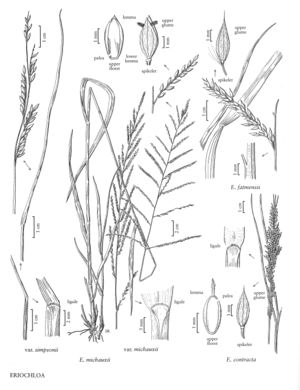Difference between revisions of "Eriochloa fatmensis"
imported>Volume Importer |
imported>Volume Importer |
||
| Line 38: | Line 38: | ||
|publication year= | |publication year= | ||
|special status= | |special status= | ||
| − | |source xml=https:// | + | |source xml=https://bitbucket.org/aafc-mbb/fna-data-curation/src/2e0870ddd59836b60bcf96646a41e87ea5a5943a/coarse_grained_fna_xml/V25/V25_1341.xml |
|subfamily=Poaceae subfam. Panicoideae | |subfamily=Poaceae subfam. Panicoideae | ||
|tribe=Poaceae tribe Paniceae | |tribe=Poaceae tribe Paniceae | ||
Revision as of 21:02, 5 November 2020
Plants annual. Culms 30-120 cm, erect or decumbent, sometimes rooting at the lower nodes; nodes and internodes glabrous. Sheaths smooth, glabrous; ligules 0.5-1 mm; blades 6-40 cm long, 3-8 mm wide, linear, flat to involute, glabrous adaxially. Panicles 6-18 cm long, 0.8-3 cm wide; rachises smooth or scabrous; branches 3-10, 25-60 mm long, 0.4-0.6 mm wide, sometimes winged, glabrous, with 20-40 spikelets, spikelets solitary or in unequally pedicellate pairs at the middle of the branches; pedicels 0.2-0.8 mm, glabrous or hairy below, apices with fewer than 10 hairs to 0.5 mm long. Spikelets 2.7-3.6 mm long, 0.8-1.5 mm wide, lanceolate. Upper glumes 1.1-1.3 times longer than the lower lemmas, hairy, 5-veined, apices acuminate and acute to awned, awns 0.3-1.5 mm; lower lemmas 2.5-3.3 mm long, 0.8-1 mm wide, setose, apices acuminate and mucronate; lower paleas absent; anthers absent; upper lemmas 1.7-2.2 mm, elliptic, acute to rounded, awned, awns 0.2-0.5 mm. 2n = unknown.
Distribution
Calif., Ariz., Miss.
Discussion
Eriochloa fatmensis is native to tropical Africa, Arabia, and India, where it usually grows in wet areas or grasslands. It has been found in Tucson, Arizona, and Biloxi, Mississippi, but is probably not established in the Flora region.
Selected References
None.
